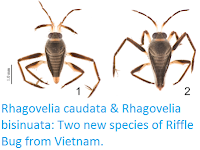Ambush Bugs, Phymatinae, are highly specialised Assassin Bugs, Reduviidae, noted for their highly modified forelegs, which are modified for seizing prey in a manner similar to Mantises. Ambush Bugs are, as their name suggests, ambush predators, and are capable of taking prey many times their own size. Ambush Bugs are global in distribution, but are more abundant in the tropics, with the Greater Antilles Islands being particularly rich in species.
In a paper published in the journal Insect Systematics and Diversity on 12 July 2019, Paul Masonick of the Department of Entomology of the University of California, Riverside, describes a new species of Ambush Bug from the Parque Nacional Sierra de Baoruco, in Pedernales Province, Dominican Republic.
The new species is named Capricephala chiaroscuro, where 'Capricephala' means 'Goat horns' in reference to four horn-like spines on the head of the species, and 'chiaroscuro' is an Italian term which refers to the composition of light and shadow in a picture, in reference to the contrasting colours of the species. The species is described from a single female specimen from the collection of the Smithsonian National Museum of Natural History in Washington, uncovered by Masonick during a review of the Ambush Bug material there. This specimen is 11.7 mm in length, making the species one of the largest Ambush Bugs described to date. The specimen was collected in June 2005 by entomologist Steve Lingafelter, in an area of cloud forest at an altitude of 1150 m.
Capricephala chiaroscuro, female specimen in dorsal view. Masonick (2019).
See also...
Follow Sciency Thoughts on
Facebook.







